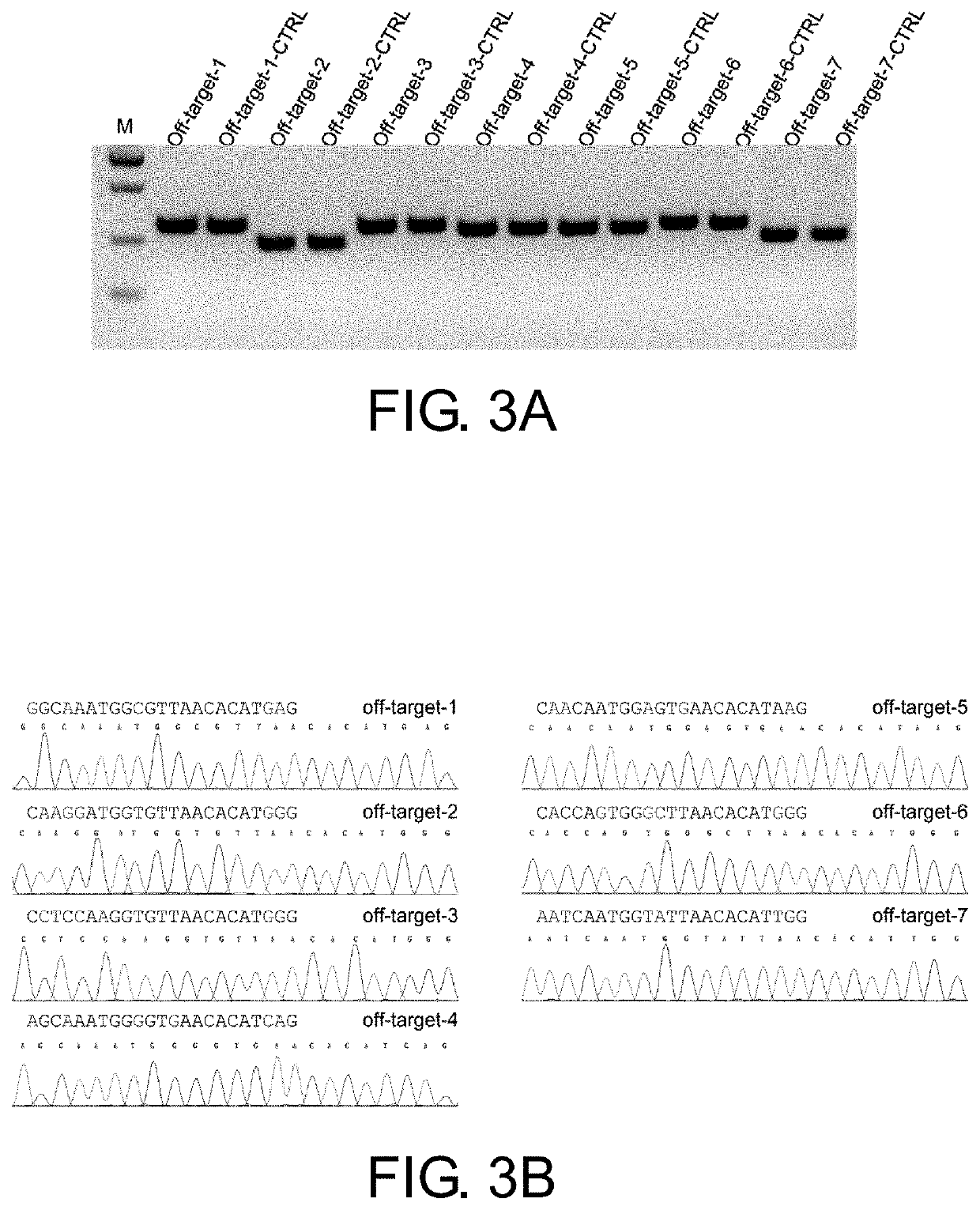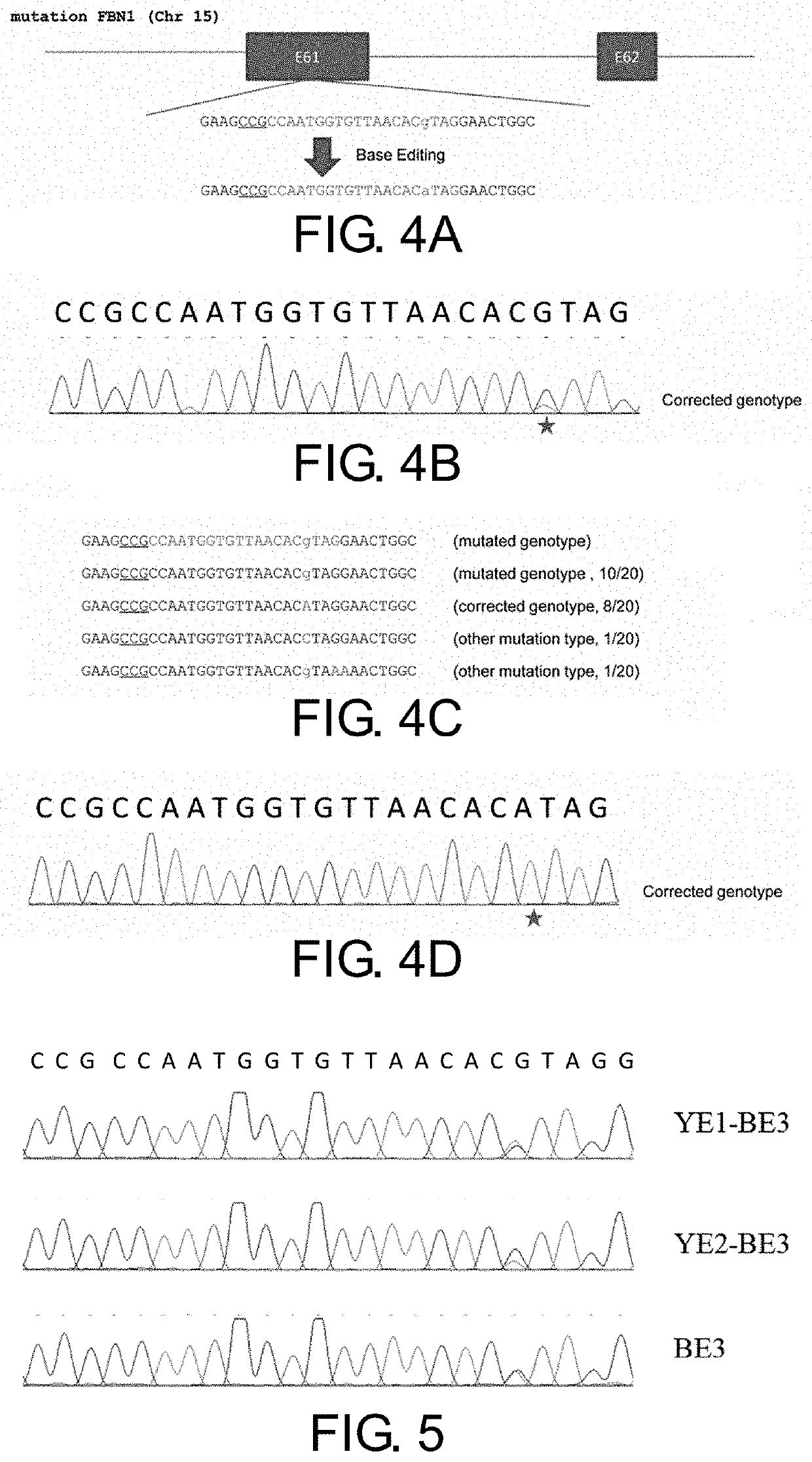Kit for reparing fbn1t7498c mutation, combination for making and repairing mutation, and method of repairing thereof
a technology of marfan syndrome and mutation, applied in the field of gene repair, can solve the problems of affecting the normal development of human connective tissues, and placing a huge burden on families and society, and achieve the effect of efficient and safe treatment methods
- Summary
- Abstract
- Description
- Claims
- Application Information
AI Technical Summary
Benefits of technology
Problems solved by technology
Method used
Image
Examples
embodiment 1
[0058]In this embodiment, a mutation FBN1T7498C mutated cell line was made by using Cas9 / sgRNA bound to ssODN on a cell line, and the mutated cell line was repaired by using a base editor (FIG. 2).
[0059]1.1 Plasmid Construction
[0060]Near a mutation site, a mutated mt-sgRNA (SEQ ID NO. 1) was designed and oligos were synthesized. The upstream sequence was 5′-taggCGCCAATGGTGTTAACACAT-3′ (SEQ ID NO. (14)), the downstream sequence was 5′-aaacATGTGTTAACACCATTGGCG-3′ (SEQ ID NO. (15)), and the upstream and downstream sequences were annealed by a procedure (95° C., 5 min; 95° C. to 85° C. at−2° C. / s; 85° C. to 25° C. at−0.1° C. / s; hold at 4° C.) and ligated to a PUC57-T7sgRNA vector (addgene: 51132) linearized with BsaI (NEB: R0539L). The linearization system was as follows: 2 μg of PUC57-T7sgRNA, 6 μL of buffer (NEB: R0539L), 2 μL of BsaI, and ddH2O complemented to 60 μL. The enzyme digestion was carried out overnight at a temperature of 37° C. A homologous template ssODN (SEQ ID NO. 2) u...
embodiment 2
[0076]In this embodiment, the mutation was repaired by using a base editor in human embryos (FIG. 7).
[0077]2.1 Plasmid Construction
[0078]Near the mutation site, according to the characteristics of base editing, a repair re-sgRNA (SEQ ID NO. 3) was designed and oligos were synthesized, the upstream sequence was 5′-taggCTACGTGTTAACACCATTGG-3′ (SEQ ID NO. 18), and the downstream sequence was 5′-aaacCCAATGGTGTTAACACGTAG-3′ (SEQ ID NO. 19). The upstream and downstream sequences were annealed by a procedure (95° C., 5 min; 95° C.−85° C. at−2° C. / s; 85° C.−25° C. at−0.1° C. / s; hold at 4° C.), and ligated to a PUC57-T7sgRNA vector linearized with BsaI (NEB: R0539L). The linearization system and procedure were as above. The ligation system was as follows: 1 μL of T4 ligation buffer (NEB: M0202L), 20 ng of linearized vector, 5 μL of annealed oligo fragment (10 μM), 0.5 μL of T4 ligase (NEB: M0202L), and ddH2O complemented to 10 μL. Ligation was carried out overnight at a temperature of 16° C....
PUM
| Property | Measurement | Unit |
|---|---|---|
| temperature | aaaaa | aaaaa |
| temperature | aaaaa | aaaaa |
| temperature | aaaaa | aaaaa |
Abstract
Description
Claims
Application Information
 Login to View More
Login to View More - R&D
- Intellectual Property
- Life Sciences
- Materials
- Tech Scout
- Unparalleled Data Quality
- Higher Quality Content
- 60% Fewer Hallucinations
Browse by: Latest US Patents, China's latest patents, Technical Efficacy Thesaurus, Application Domain, Technology Topic, Popular Technical Reports.
© 2025 PatSnap. All rights reserved.Legal|Privacy policy|Modern Slavery Act Transparency Statement|Sitemap|About US| Contact US: help@patsnap.com



